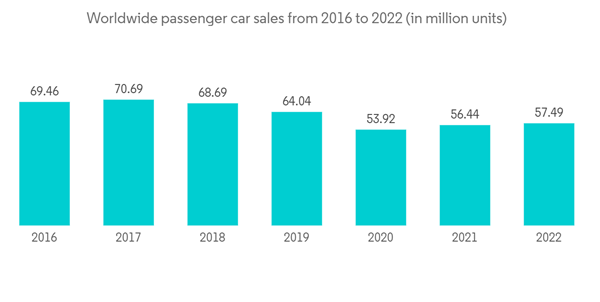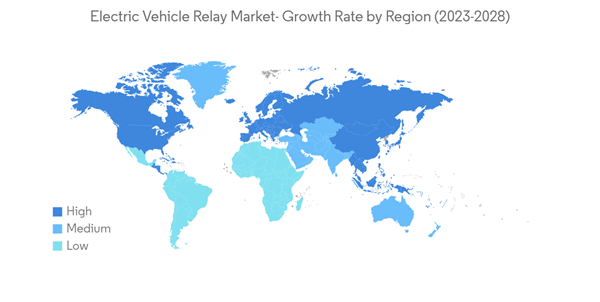The Electric Vehicle Relay Market size is estimated at USD 11.78 billion in 2024, and is expected to reach USD 27.23 billion by 2028, growing at a CAGR of 14.10% during the forecast period (2024-2028).
The market is expected to be driven by the rising adoption of electric vehicles. Moreover, initiatives taken by the government to boost sales of electric vehicles and stringent policies to reduce CO2 emissions will drive the market growth. Hence, there has been widespread utilization of these technologies in various automotive applications.
For instance, according to the International Energy Agency, more than 10 million electric cars will be sold worldwide in 2022, and sales are expected to grow by another 35% to reach 14 million in 2023.
Relay plays an important role in various kinds of applications such as on-board chargers, lamp controls, various motor controls, heater controls, and solenoid controls. With the high demand for electric vehicles, relay manufacturers are focusing on technological advancements in their products.
For example, in May 2022, Texas Instruments (TI) is rolling out two solid-state relay chips designed to replace traditional automotive mechanical relays.
Asia Pacific is expected to hold the highest share. In India, EV and component manufacturing is ramping up, supported by the government’s USD 3.2 billion incentive program that has attracted investments totaling USD 8.3 billion in 2022. Thailand and Indonesia are also strengthening their policy support schemes, potentially providing valuable experience for other emerging market economies seeking to foster EV adoption.
Thus, the above factors will likely drive market growth.
The increasing adoption of relays in passenger vehicles for driver convenience is favorably impacting the growth of the market studied. This is also attributed to the rising demand for vehicle safety and comfort components. Various Government measures and car crash test organizations like the Global New Car Assessment Program (GNCAP), which publishes car safety ratings, have created awareness among many car buyers regarding the importance of building quality vehicles and other safety features.
Considering this, the automakers are focusing more on advanced safety features in vehicles to cater to the rising demand for advanced safety features in vehicles. Some of the common active safety features include an anti-lock braking system (ABS), Electronic Stability Control (ESC), Tyre Pressure Monitoring System (TPMS), Lane Departure Warning System (LDWS), etc. For example, Hyundai Motors launches new safety features like Vehicle Stability Management and 3-point seatbelts in its upcoming models.
Moreover, government policies to promote the production of much safer cars drive the market growth. For instance, in August 2023 Ministry of Road Transport & Highways launched the Bharat New Car Assessment Programme (Bharat NCAP). This program is a significant step forward in the Government’s commitment to improving road safety by raising the safety standards of motor vehicles to 3.5 tons in India.
Thus, the above factors drive market growth.
China and India are considered to be the major automotive consumers and hold a significant share of automotive demand across the world. Factors such as rising middle-class income and a huge youth population will result in strong demand.
For instance, A study by the CEEW Centre for Energy Finance recognized a USD 206 billion opportunity for electric vehicles in India by 2030.
The Governments of countries like India and China are focusing on policies to promote sales of electric vehicles and become a worldwide leader in the EV industry by introducing Initiatives for electric vehicles. Moreover, the Government has developed several programs and incentives to increase demand for electric cars. Automotive manufacturers are investing in the R&D of electric vehicles and related infrastructure.
The Government of India is projecting 30% EVs by 2030 by implementing cheaper road fees, scrapping, and refit incentives.
Moreover, the growing expense of oil imports and increased levels of pollution make governments expedite the transition to e-mobility.
With the growth of electric vehicle sales across the globe, the demand for electric vehicles really will also grow exponentially, and companies are focusing on increasing their production capacity to cater to the high demand. Considering the scenario, the market is expected to grow.
In August 2023, LS e-Mobility Solutions, a subsidiary focused on electric vehicle (EV) components under LS Electric Co., secured a supply contract valued at 250 billion won (USD187 million) to provide relays for electric vehicles manufactured by Hyundai Motor Co. and Kia Corp. The agreement was officially announced by LS Electric, highlighting that LS Mobility Solutions, a branch of LS e-Mobility Solutions, has entered into a contract with Hyundai-Kia Motors. The agreement entails the supply of EV relays for electric vehicles. The components are scheduled for delivery in the first half of 2025.
Some of the major players in the market include Panasonic Corporation, Texas Instruments, Omron Corporation, and Fujitsu Limited.
This product will be delivered within 2 business days.
The market is expected to be driven by the rising adoption of electric vehicles. Moreover, initiatives taken by the government to boost sales of electric vehicles and stringent policies to reduce CO2 emissions will drive the market growth. Hence, there has been widespread utilization of these technologies in various automotive applications.
For instance, according to the International Energy Agency, more than 10 million electric cars will be sold worldwide in 2022, and sales are expected to grow by another 35% to reach 14 million in 2023.
Relay plays an important role in various kinds of applications such as on-board chargers, lamp controls, various motor controls, heater controls, and solenoid controls. With the high demand for electric vehicles, relay manufacturers are focusing on technological advancements in their products.
For example, in May 2022, Texas Instruments (TI) is rolling out two solid-state relay chips designed to replace traditional automotive mechanical relays.
Asia Pacific is expected to hold the highest share. In India, EV and component manufacturing is ramping up, supported by the government’s USD 3.2 billion incentive program that has attracted investments totaling USD 8.3 billion in 2022. Thailand and Indonesia are also strengthening their policy support schemes, potentially providing valuable experience for other emerging market economies seeking to foster EV adoption.
Thus, the above factors will likely drive market growth.
Electric Vehicle Relay Market Trends
Passenger Car holds Highest Share in the Market
Passenger cars have gained immense popularity among drivers over the past few years due to features such as stylish design, compact size, and economic value. Passenger cars are the most common mode of transportation in numerous advanced countries. The improving lifestyles, increasing disposable income, raising brand awareness, and economy are leading to customer preference changes across the globe, resulting in high sales of passenger cars.The increasing adoption of relays in passenger vehicles for driver convenience is favorably impacting the growth of the market studied. This is also attributed to the rising demand for vehicle safety and comfort components. Various Government measures and car crash test organizations like the Global New Car Assessment Program (GNCAP), which publishes car safety ratings, have created awareness among many car buyers regarding the importance of building quality vehicles and other safety features.
Considering this, the automakers are focusing more on advanced safety features in vehicles to cater to the rising demand for advanced safety features in vehicles. Some of the common active safety features include an anti-lock braking system (ABS), Electronic Stability Control (ESC), Tyre Pressure Monitoring System (TPMS), Lane Departure Warning System (LDWS), etc. For example, Hyundai Motors launches new safety features like Vehicle Stability Management and 3-point seatbelts in its upcoming models.
Moreover, government policies to promote the production of much safer cars drive the market growth. For instance, in August 2023 Ministry of Road Transport & Highways launched the Bharat New Car Assessment Programme (Bharat NCAP). This program is a significant step forward in the Government’s commitment to improving road safety by raising the safety standards of motor vehicles to 3.5 tons in India.
Thus, the above factors drive market growth.
Asia-Pacific holds Highest Share in the Market
The Asia-Pacific region is expected to hold a notable share of the market during the forecast period owing to rising demand from key markets like India, China, Japan, and others.China and India are considered to be the major automotive consumers and hold a significant share of automotive demand across the world. Factors such as rising middle-class income and a huge youth population will result in strong demand.
For instance, A study by the CEEW Centre for Energy Finance recognized a USD 206 billion opportunity for electric vehicles in India by 2030.
The Governments of countries like India and China are focusing on policies to promote sales of electric vehicles and become a worldwide leader in the EV industry by introducing Initiatives for electric vehicles. Moreover, the Government has developed several programs and incentives to increase demand for electric cars. Automotive manufacturers are investing in the R&D of electric vehicles and related infrastructure.
The Government of India is projecting 30% EVs by 2030 by implementing cheaper road fees, scrapping, and refit incentives.
Moreover, the growing expense of oil imports and increased levels of pollution make governments expedite the transition to e-mobility.
With the growth of electric vehicle sales across the globe, the demand for electric vehicles really will also grow exponentially, and companies are focusing on increasing their production capacity to cater to the high demand. Considering the scenario, the market is expected to grow.
Electric Vehicle Relay Industry Overview
The electric vehicle relay market is consolidated and led by globally and regionally established players. The companies adopt strategies such as new product launches and collaborations to sustain market positions. For instanceIn August 2023, LS e-Mobility Solutions, a subsidiary focused on electric vehicle (EV) components under LS Electric Co., secured a supply contract valued at 250 billion won (USD187 million) to provide relays for electric vehicles manufactured by Hyundai Motor Co. and Kia Corp. The agreement was officially announced by LS Electric, highlighting that LS Mobility Solutions, a branch of LS e-Mobility Solutions, has entered into a contract with Hyundai-Kia Motors. The agreement entails the supply of EV relays for electric vehicles. The components are scheduled for delivery in the first half of 2025.
Some of the major players in the market include Panasonic Corporation, Texas Instruments, Omron Corporation, and Fujitsu Limited.
Additional Benefits:
- The market estimate (ME) sheet in Excel format
- 3 months of analyst support
This product will be delivered within 2 business days.
Table of Contents
1 INTRODUCTION
4 MARKET DYNAMICS
5 MARKET SEGMENTATION
6 COMPETITIVE LANDSCAPE
Methodology

LOADING...










